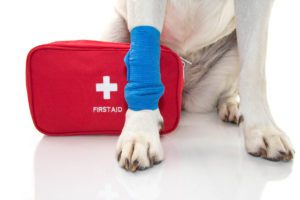Signs My Pet is Having an Emergency in Mishawaka, IN
We know our pets better than anyone else, and they rely on us to advocate for their health. If you notice that your pet is acting strangely, be wary! Time is often a key factor in the outcome for your pet’s survival in an emergency. Our pets often act tougher than they are, so it’s important not to ignore any strange symptoms you notice.
While our pets are family members to us, they are still animals, so it is important to stay calm and cautious around your pet in an emergency situation. Animals are driven by their prey or predator instincts, and in the wild being sick or injured demonstrates weakness. In nature, it is dangerous for an animal to appear weak, and even now that they are domesticated, pets will often downplay their symptoms or act aggressively out of fear or self defense. It is important to be calm and cautious around your pet during emergency situations, as they could act very differently than they normally do.
If you notice anything wrong with the way your pet is acting, breathing, digesting food, or if it has had an injury, it’s probably time to get your pet to the vet!
In an emergency, it is important to observe anything that might be helpful for your vet to know before they start treating your pet. Record as many vital signs as possible, including their temperature, respiration rate, and heart rate so that your vet can determine if your pet is relatively stable, or the rate at which they are deteriorating as soon as your pet arrives.
Stay calm, but vigilant. Your pet needs you to help keep them calm. If you notice any of the following symptoms in your pet, its time to head to the vet’s office!

Abnormal Vital Signs and Neurological Emergency Symptoms
If you suspect your pet is having an emergency, the first thing you are going to want to check are his vital signs. If you can, check your pet’s temperature, respiration rate, and heart rate and record their statistics to report to the vet so that they have an idea how quickly your pets condition is changing.
Vital signs outside the range of normal suggest that something serious, probably life threatening, is wrong with your pet, and you need to call your veterinarian immediately! Dogs, generally have a temperature range between 100-102.5 degrees, a respiration rate between 15-30 breaths per minute, and a heart rate of 70 to 140 beats per minute (50-120 beats per minute for larger breed dogs).
Cats should also have a temperature between 100-102.5, a respiration rate of 15-30 breaths per minute, and a heart rate of 140-200 beats per minute.
In order to take your pet’s respiration rate, count how many times your pets rib cage expands and contracts for six seconds, than multiply that number by 10. You can feel your pets heart rate by placing your fingers on your pets chest under their elbow, count the beats for six seconds, and multiply by 10 again.
Neurological symptoms are usually acute symptoms that your pet is having an emergency. Neurological symptoms occur when something is affecting the way your pet’s brain is communicating with his body. Lots of things can cause neurological symptoms including poison, injury, or underlying disease. Common neurological symptoms include lethargy, loss of balance, seizures, and loss of consciousness. If any of these things happen to your pet, its time to rush to the emergency clinic!
Respiratory Emergency Symptoms
Finding your pet struggling to breathe is terrifying and feels like a hopeless situation. There are a few reasons your pet might be in respiratory distress, including allergic reaction, inflammation, or an obstructed airway. If you notice that your pet has collapsed or that their mouth or tongue has turned blue, they are not getting enough oxygen and need first aid immediately! Gagging is a sign that your pet may have something stuck in their airway, which is a life threatening situation.
Other reasons for respiratory distress include allergies, or insect bites. If you don’t suspect that your pet has ingested anything that may have gotten stuck in their airway, it is possible that their airway has been restricted due to a severe immune response to and allergen or insect bite causing inflammation of the respiratory tract. Injuries to your pets face or throat could also cause swelling that can impede your pet’s airway.
Digestive Emergency Symptoms
Its usually pretty easy to know if your pet is having a digestive emergency, because they will usually leave you with a big mess to clean up! Pets eat a lot of things, not all of them are good for them. Keeping your pet’s routine consistent will help you to know when your pet is going to use the bathroom, which will help you notice if your pet has any underlying digestive issues before they become emergencies.
While a lot of digestive issues can be managed with preventative care and good nutrition, most digestive emergencies happen because your pet has snacked on something their body didn’t agree with. If your pet eats something their body can’t break down, like a shred from a chew toy, or a sock that “went missing” whatever it ate could get stuck inside their digestive system and block waste from moving through the body.
If an object blocks your pets digestive tract, it is called and obstruction, which is considered a life threatening condition that most often requires surgery to resolve. If you notice that your pet is struggling to pass waste, you should get them seen immediately, there’s a good chance there is something stuck in their digestive tract and its important to get it out before its too late!
If your pet eats something they aren’t supposed to, but it is small enough to move through the digestive system, their body will react by trying to expel the substance as quickly as possible. This frequently looks like excessive vomiting and diarrhea or worse, serious poisoning symptoms. Vomiting and diarrhea are dangerous, as it can lead to dehydration and declined condition quickly.
Other life threatening symptoms that indicate a dog has consumed something toxic include drooling excessively, loss of appetite, muscle tremors, collapse, trouble breathing, sores or burns on the mouth or skin from consuming chemicals or other irritating substances, and discolored gums. What your pet has eaten, how much of it they consumed, and how large your pet is, will play a big factor in the severity of their condition.
Traumatic Injury
Unfortunately with pets, even if we are super careful, accidents can happen. We do our best to protect our pals, but sometimes they get themselves hurt! Its scary when our pets get hurt, but they will handle their pain better if you are able to stay as calm as possible in order to keep your pet from panicking.
Pets can be pretty clumsy and often crash and burn while they are playing. It is important to keep a close eye on your pet so that you can notice if they have an accident. Keep tabs on their reaction to the accident, do they seem dazed, or do they walk it off pretty quickly and keep playing? Its important to consider that the body’s natural response to trauma is to compensate for the injury and maintain the body’s ability to keep the vital organs functioning.
If your pet has been in an accident in which they have suffered excessive internal or external bleeding, consider weather they are in shock. Pale gums, a shallow rapid heartbeat, and loss of body heat, are all signs that your pet is in shock and that their body is over compensating for their injury, causing excessive blood supply to the vital organs, dangerously low blood pressure, and eventually oxygen starvation to the brain.
If your pet has a serious traumatic injury they will display pain signals including antisocial or aggressive behavior, changes in diet or sleeping habits, whining, crying or barking, constant licking of the area, or heavy panting. If your pet has been in an accident and you suspect that internal bleeding or broken bones may be present, you should get your pet to the emergency vet immediately for x-rays and ultrasounds to determine the severity of the internal damage, manage your pet’s pain, and develop a treatment plan to get your pet back on the road to recovery.

Open Wounds and Broken Bones
Wounds and broken bones are another common trauma that requires emergency treatment. Animal fights and accidents are common, and its not unlikely your pet will end up with a scrape or cut eventually. Deep lacerations and puncture wounds are the most life threatening types of wounds. A deep cut, especially on the head or chest cavity, can be very dangerous as they are likely to bleed excessively and can leave the body open to infection.
Deep lacerations usually require stitches, which have to be administered within 6 to 8 hours, so its important to catch this emergency quickly! A bite wound is often a deep puncture wound, which creates a deep pocket for foreign materials and infection to gather, so its important to get your pet to a vet so that they can properly clean the wound and administer antibiotics to fight infection. Any type of uncontrolled bleeding, especially if the blood is pulsing or spurting, requires immediate first aid followed by emergency care!
If you suspect a bone is broken or displaced, it is best to immobilize the injured area as best you can and get your pet to an emergency clinic that can do the proper imaging to determine what has been injured so that your vet can come up with a proper treatment plan. Remember your pet might be unusually protective over their injuries, so only immobilize them if it is safe, otherwise trust your pet to protect themselves until you get them help!
Conclusion
Despite our best efforts, emergencies are often unavoidable. The best thing you can do is keep your pets in the safest possible environments, keep a close eye on them, and educate yourself on what signs and symptoms to look for if you think your furry friend is in need of urgent care.
If your pets temperature, respiration, or heart rate are outside of their normal range, they are experiencing neurological, respiratory, digestive emergency symptoms or have recently experienced a traumatic injury, its definitely a good idea to give your vet a call right away!
Emergencies are sometimes inevitable, but you can be prepared ahead of time for an emergency with your pet. Do what you can to prevent accidents and injuries by keeping your environment safe and animal friendly, maintain a great relationship with your regular vet, but also research a few emergency vet offices that you could take your pet to in case your every-day veterinarian is unavailable or doesn’t have the imaging equipment necessary to diagnose and treat a traumatic emergency.
Having a complete, fully stocked first aid kit might be a literal life saver for your pet and should include things like gauze, non-stick bandages, adhesive tape, cotton balls, hydrogen peroxide, antibiotic ointment, milk of magnesia and charcoal to counteract poisons, a digital thermometer, scissors, tweezers, magnifying glass, syringes, flashlight, towel, and muzzle.
Teaching your pet good social skills, as well as how to travel calmly and safely in your car is another way to prepare your furry friend for an emergency. If they are calm and comfortable with being transported while they are feeling healthy, it will be a lot less traumatic for your pet if they need to travel in your car for emergency treatment.
When in doubt, it is always a good idea to call your vet if you are worried about your pet. Even if they are not having an emergency, its always better to be safe than sorry!

